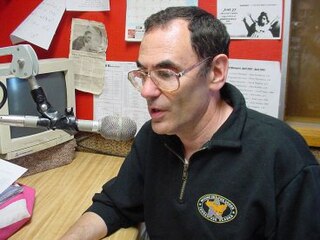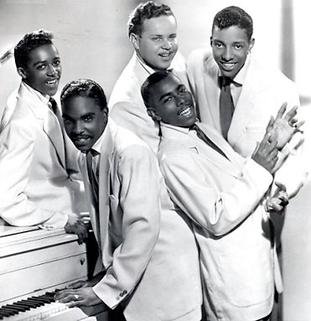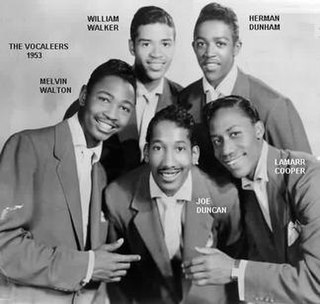Related Research Articles
The Turbans were an American doo-wop vocal group that formed in Philadelphia, Pennsylvania in 1953. The original members were: Al Banks, Matthew Platt, Charlie Williams (baritone), and Andrew "Chet" Jones (bass). They came from Downtown Philadelphia.
The Robins were a successful and influential American R&B group of the late 1940s and 1950s, one of the earliest such vocal groups who established the basic pattern for the doo-wop sound. They were founded by Ty Terrell, and twin brothers Billy Richards and Roy Richards. Bobby Nunn soon joined the lineup. They began their career as the Bluebirds but switched to recording as the Robins in May 1949. In 1955, the group disagreed over whether to remain on the West Coast or sign with Atlantic Records and move to the East Coast. This led to a split within the group. Music producers and songwriters Jerry Leiber and Mike Stoller took former Robins members Nunn and Carl Gardner, recruited singers Leon Hughes and Billy Guy, and formed the Coasters. The founding Richards brothers and Tyrell continued to record as the Robins until 1961.
The Ravens were an American R&B vocal group, formed in 1946 by Jimmy Ricks and Warren Suttles. They were one of the most successful and most influential vocal quartets of the period, and had several hits on the R&B chart in the late 1940s and early 1950s.
The Wrens were an American doo-wop vocal group from The Bronx, New York City. They are best known for their song "Come Back My Love" and "I'm Just the Kind of Guy".
The Cadillacs were an American rock and roll and doo-wop group from Harlem, New York, active from 1953 to 1962. The group was noted for their 1955 hit "Speedoo", written by Esther Navarro, which was instrumental in attracting white audiences to black rock and roll performers.

Marv Goldberg is an American writer and historian of music in the field of rhythm & blues.
The Harptones are an American doo-wop group, which formed in Manhattan in 1953.
The Dubs are an American doo wop vocal group formed in 1956, best known for their songs "Could This Be Magic", "Don't Ask Me to Be Lonely" and "Chapel of Dreams".

The Chords were an American doo-wop vocal group formed in 1951 in The Bronx, New York, known for their 1954 hit "Sh-Boom", which they wrote. It is the only song they created that reached mainstream popularity.

Billy Ward and his Dominoes were an American R&B vocal group. One of the most successful R&B groups of the early 1950s, the Dominoes helped launch the singing careers of two notable members, Clyde McPhatter and Jackie Wilson.
Otis Williams and the Charms were an American doo-wop vocal group in the 1950s, who were originally billed as The Charms. Williams is not related to Otis Williams of The Temptations.
The Larks were an American vocal group, active in the early 1950s. They were not the same group as the Los Angeles–based Larks featuring Don Julian, nor the Philadelphia-based group The Four Larks.
The Charts were an American doo-wop group of the 1950s, most famous for their recording "Deserie".

The Solitaires were an American doo-wop group, best known for their 1957 hit single "Walking Along". Although they never had a national chart hit, they were one of the most popular vocal groups in New York in the late 1950s.
"Jim Dandy" is a song written by Lincoln Chase, and was first recorded by American R&B singer LaVern Baker on December 21, 1955. It reached the top of the R&B chart and #17 on the pop charts in the United States. It was named one of The Rock and Roll Hall of Fame's 500 Songs that Shaped Rock and Roll and was ranked #352 on Rolling Stone's 500 Greatest Songs of All Time.
William Luther Johnson was an American alto saxophonist, clarinetist, and arranger.
The Monotones were a six-member American doo-wop vocal group in the 1950s. They are considered a one-hit wonder, as their only hit single was "The Book of Love", which peaked at No. 5 on the Billboard Top 100 in 1958.

The Checkers were an American doo-wop quintet formed in 1952. The original members were John Carnegie (Tenor/Lead), Charlie White (Tenor/Lead), Irwin "Teddy" Williams (Tenor), James Turner "Buddy" Brewer (Baritone), and Bill Brown. The group, only having recorded 25 singles for the King Records imprint and their subsidiary Federal Records broke up in 1955. The most notable aspect of the group was their constantly changing sound due to the 5 personnel changes that happened within their short existence. King kept on releasing bands under the pseudonym of "The Checkers" until the mid 70s.

The Vocaleers were an American doo-wop group formed in Harlem, New York, in 1952. Managed by record producer Bobby Robinson, the group released a string of regional hits and scored one national R&B hit with the song "Is It a Dream" in 1953. Highlighted by the distinctive vocal delivery of Joe Duncan, "Is It a Dream" became a standard component of several R&B acts in Harlem and, briefly, the Vocaleers were among the most popular attractions of the city's music scene.

"When My Little Girl Is Smiling" is a pop song written by Gerry Goffin and Carole King, and first recorded by The Drifters in 1961.
References
- 1 2 3 4 5 "Meet The Mello-Moods, the teen doo-wop group that started it all". Goldmine Magazine: Record Collector & Music Memorabilia. 19 July 2011. Retrieved 2022-09-02.
- ↑ "The Dead Rock Stars Club - The 1960s". Thedeadrockstarsclub.com. Retrieved 2023-08-31.
- ↑ "The Dead Rock Stars Club - 2011 January to June". Thedeadrockstarsclub.com. Retrieved 2023-08-31.
- 1 2 "Marv Goldberg's R&B Notebooks - The Mello-Moods". Uncamarvy.com. Retrieved 2023-08-31.
- ↑ Goldmine Staff (2011-03-04). "Obituaries for Johnny Preston, Suze Rotolo, Grady Chapman and more". Goldmine Magazine: Record Collector & Music Memorabilia. Retrieved 2023-08-31.
- ↑ "The Dead Rock Stars Club - The 1980s". Thedeadrockstarsclub.com. Retrieved 2023-08-31.
- ↑ "Marv Goldberg's R&B Notebooks - THE SOLITAIRES". Uncamarvy.com. Retrieved 2023-08-31.